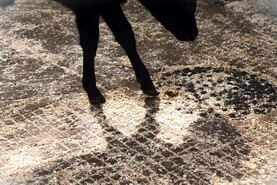Scott Bourman got his start in farming by helping out on his grandparents’ farm. He is currently farming at Middlehouse in Lanarkshire, having begun work at the farm in 2011 when he moved there to join family relatives John and Robert Stevenson. “Having helped – or hindered – on my grandparents’ farm any time I visited them from a young age, until they retired some 16 years ago, I knew I was silly enough to become a farmer,” said Scott.
He added: “Finding myself at a loose end after this, I approached neighbouring farmer Ian Nimmo, from Bogside, willing to help out. This luckily coincided with my school Easter holidays and his lambing being full swing, so I bagged myself the job of lambing pen feeder.
“From there on, I helped from day-to day after school and during holidays. On leaving school I secured a fulltime job there.”
Scott went on to study agriculture at SAC Auchincruive in Ayr, where he gained his HND. Scott then travelled to Canada for the summer of 2011, before coming back to Scotland to begin his work at Middlehouse. He said: “I worked for the business and also bought my first sheep, which were in-lamb ewes, around the start of February. I lambed them the following spring and sold the lambs finished for an average of £62 and the ewes cast for an average of £35 by the end of June. This was where I caught the bug for buying and selling.”
Scott has since built himself up to be main shareholder of the business: “I have stuck with the strategy drilled into me from Robert; buying something when no one wants it and selling it when they do.”
Farming going forward will have to get more efficient according to Scott. “Smaller-sized farms will struggle unless they are very specialised,” he added. Scott acknowledges the challenges young farmers will experience including the price of land and stock.
“The external market factors create uncertainties for farmers. Lamb for example could come under pressure because of the export market,” he added.
Business at Middlehouse Farm
Middlehouse Farm currently runs a summer stocking rate of 1.7 livestock units (LU) per acre, with a throughput of four units sold per acre each year, predominantly made up of bulling heifers, which are sold with calves at foot mainly at Carlisle or in private sales.
Cast cows and some store cattle are also finished through the year and Scott tries to finish as much as he can on grass alone.
On the sheep side of the business, Scott generally buys around 400 in-lamb ewes throughout February and March, which are then lambed in April. These are usually sourced through local auctions or privately. Then short-keep store lambs are bought from September through to February for winter grazing or forage crops. Usually stubble turnip or kale. All of the sheep will be sold finished, when ready, to Scotbeef for M&S or local markets.
Importance of investment in infrastructure
“I have invested in good handling facilities over the last number of years, I’m confident farming has a sustainable future for proactive farmers who keep investing in infrastructure, which allows few staff to maintain large amounts of stock and area efficiently,” said Scott.
He added: “Maximising returns from the land is important to me, by maintaining drains, regular ploughing and re-seeding – grass yields and stocking densities definitely can be significantly increased, particularly through simple things like pH management. After all, you wouldn’t throw half your fertiliser away, so why apply it to a soil of pH 5.0.”
Young Farmers
Outside of his day-to-day farming life, Carluke Young Farmers Club has been a big part of Scott’s life – having been a member since he was 14-years-old and in the position of both club and Lanarkshire district chair. He said: “The activities which the organization hosts and provides throughout the year are fantastic.
“I’d undoubtedly recommend SAYFC to anyone, as it’s not just for those who wear wellies.”
Speaking about the trip to California in winter, Scott sees it as a great opportunity: “It will be good to see large-scale farming that is intensive but efficient. It’ll be interesting to see different crops grown that you wouldn’t see back home as well.”
As well as an educational trip, Scott looks forward to the social aspect. He added: “I don’t know many of the farmers who will be heading away on the trip, I’d know of some, but it will be a great experience to get to know new faces.
“It’s almost better in a way, when you know no one in a large group it’s easier to branch out and really meet new people.”






 This is a subscriber-only article
This is a subscriber-only article









SHARING OPTIONS: